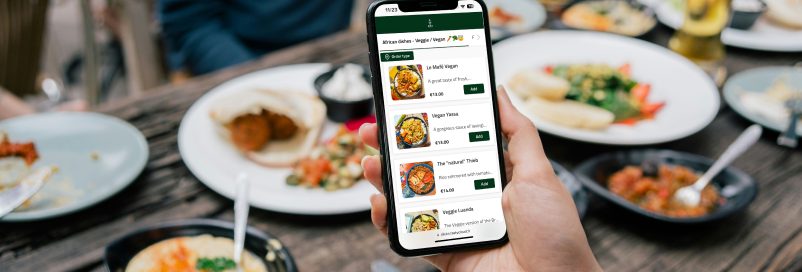What is a digital menu?
A digital menu is an electronic version of a traditional menu generally found in restaurants, cafés, bars or any other catering establishment. Unlike paper menus, digital menus can be accessed via electronic devices such as smartphones, tablets, touch screens or QR codes.

How does it work?
To digitise your restaurant, bar or room service menu, all you need to do is follow a few simple steps to ensure a smooth and efficient transition:
- Ensure that the menu to be converted is up to date. This includes prices, descriptions, personalisation options, information on allergens, languages, etc.
- Carry out a photo shoot of the items on the menu: starters, main courses, drinks and other accompaniments. Take high-quality photos of your dishes and drinks. Attractive images can increase sales and improve the customer experience.
- Use the platform’s tools to import and organise your menus. You can often copy and paste text or upload files. With specific training and support beforehand, each operator is autonomous when it comes to importing their menu and making changes as they see fit.
- Adapt the digital menu interface to your establishment’s brand image. It is advisable to add your logo, colours and fonts that reflect your visual identity.
- In your account settings, you can set up your menu for the medium of your choice: a touch-sensitive tablet, a QR code or online ordering.
- Integrate the digital menu into your website and social networks.
- Use the analysis tools provided by the platform to track order trends and customer behaviour.
How does it work for customers?
Customers can access the digital menu in different ways:
- with a QR code: A QR code is usually displayed on the restaurant table, at the bar in the room, or in the hotel’s common areas. By scanning the code with their smartphone, customers are redirected to the digital menu.
- with a direct URL for online ordering: The digital menu can also be accessed via a direct URL indicated on the till receipt or posters in the restaurant.
- With a tablet menu: Customers can consult the digital menu via a touch-sensitive tablet for a premium experience.
Understanding the benefits of a digital menu
There are many advantages to a digital menu:
Easy updating
Updates to the menu, product and price changes, new dishes or special promotions can be updated in real-time without printing costs.
Enhanced user experience
In addition, digital menus can include high-resolution images of each dish or drink, detailed descriptions, filtering options (tags indicating vegetarian, gluten-free, organic, AOC, AOP, etc.) and personalised recommendations.
An ecological approach
Using a digital menu reduces the use of paper, helping to protect the environment. This eco-responsible approach contributes to obtaining numerous labels. It is an evaluation criterion for hotel and restaurant labels such as Clé Verte, Ecotable, Hotel Classification, etc.
Accessibility
Customers can consult the menu from their own mobile devices, eliminating the need to handle physical menus. This is particularly appreciated in a demanding health context, or when catering for hygiene-sensitive international tourists.
Technological integration
The digital menu can also be integrated with online ordering systems, loyalty programs, and digital payment platforms. It offers a fluid, modernised ordering experience.
It can also be integrated into the restaurant’s website or social networks, giving it greater visibility and helping to build customer loyalty.
A multilingual welcome
Finally, the digital menu is a major asset for welcoming international customers. Whether on a tablet, QR code or online, a complete solution can offer up to 25 languages. This is a great opportunity to showcase your offer and reassure customers about their choices.

Measuring the economic benefits
Digitising menus in restaurants, bars and hotels has a significant economic impact.
Here are the main economic impacts:
Increased revenue
- Increased number of orders: Digital menus can display attractive images and detailed descriptions. This encourages customers to order more dishes or choose more expensive options.
- Easier upselling: Automatic suggestions for drinks, desserts or side dishes can increase the average bill per customer. In fact, reading the entire digital menu has a positive impact on additional sales, because the experience is more fun and attractive.
- Dynamic promotions: special offers and promotions can be easily highlighted, encouraging customers to take advantage of temporary offers.
Improved operational efficiency
- Lower printing costs: the digital menu eliminates the recurring expense of printing and reprinting physical menus each time they are changed or updated.
- Simplified management: Updates can be made instantly online. This reduces the management time and costs associated with administering physical menus.
Customer loyalty and satisfaction
- Enhanced customer experience: An improved user experience, thanks to interactive and personalised menus, can lead to greater customer satisfaction and loyalty.
- Customer data history: Digital menus can be used to collect data on customer preferences and behaviour. This can be used for targeted marketing strategies and personalised offers. In effect, you have your own customer file to launch campaigns at your convenience and reactivate existing customers.
Competitive advantages
- A modern, innovative image to stand out from the crowd: Digitalising menus can attract a younger, more tech-savvy clientele. This enhances the restaurant’s brand image.
- Reactivity to market trends: The ability to quickly modify the menu in line with market trends and demands enables the establishment to remain competitive. It’s an invaluable management tool for ensuring the long-term future of your business.
Gathering customer reviews
At the end of the meal, customers can share their reviews via the digital menu. This allows the restaurateur to collect all the customer comments in real-time. Thanks to their access to the management interface, they can consult valuable information such as the customer’s name, e-mail address and the rating given. This data is invaluable for rethinking the menu, adjusting prices or improving service.
